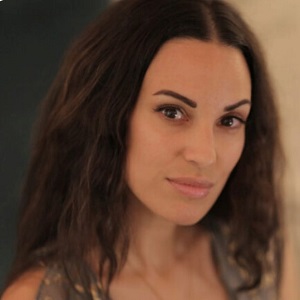Can you write a book like you build a product?
Most people don’t think so.
After all, the argument goes – writing fiction is art while developing a product is more of a science. It’s like oil and water. The two never mix.
But why not? A book is a product too.
In order for it to be a bestseller, it has to capture and captivate it’s readers (i.e user). It has to make money for the author & publisher (i.e business impact), and it needs to be delivered within a certain time frame within a certain format (i.e technically feasible).
Sounds to me a lot like a definition of a product.
Rita J King believes it to be true. She is currently leveraging product principles to help her finish her novel.

Rita J. King is the EVP for Business Development at Science House in Manhattan and a Resident Research Fellow at The Center for Engineered Natural Intelligence at UC San Diego. She is a writer, speaker and artist.
She created The Imagination Age framework, to help organizations transition from the Industrial to the Intelligence Era. And works extensively with teams to help them take ideas to market quickly as co-founder of Model Meetings, a Science House product..
She is also a writer, speaker and artist. And I am so glad to have her as a guest on our next installment of Masters of Product interviews.
To help us marry these two – what would seem to be opposite worlds. I sat down with Rita to find out how she is leveraging a product mindset to write her book.
What follows below is a lightly edited version of our interview.
Rita, thank you for joining us. Let’s start with the most obvious question….tell me more about the novel you are writing?
Rita J. King: Thanks Mustafa. I’m excited that you’re including my work as part of your interview series.
This book is a personal passion project. The process started when I was researching my family history on a volcanic island called Ischia, off the coast of Naples. I learned about a remarkable woman born in 1492. She was the first Italian woman to publish a book of her own poetry, she was a strategist in her family’s war business, and she closely collaborated for years with Michelangelo.
Ultimately, I decided to tell her story as a work of fiction.
I just love the premise of the book. And I can’t wait to read it. Now before we dive deep into how having a “product mindset” helped you write this book. I want to step back and ask about your journey. From our previous conversations, it has been quite a few years in the making. Is that right?
RJK: Yes. Nine years. Nine long years.
It started with curiosity. I learned, read and took notes.
Then those notes turned into a biography, then historical fiction. Something wasn’t clicking for me despite my interest and lifelong passion for reading and writing. I even experimented with using Agile software development methodology to organize the story. As much as I love doing historical research, I didn’t love writing a story set five centuries ago. I love capturing the visceral details of the moment we’re in. So I decided to set the story in the present.
Recently, I had a conversation with one of my creative collaborators, Dr. Deirdre Kelly. She asked me whether I was writing for myself, in which case the output was a monologue, or for readers, in which case it was a dialogue inviting a response. That conversation impacted me very deeply and that is what led me to start thinking of the book as a product. So I started over from page zero, with only the reader in mind.
Wait a minute. Did you just say that you used agile to help you write the book? Please elaborate.
RJK: I’m the EVP for Business Development at Science House. At the beginning of the pandemic, I worked with our clients to transition massive software planning meetings to Zoom. In doing this, I became familiar with every aspect of Agile planning. I had never thought of the idea of writing a book being similar to writing code. But I kind of liked the idea of breaking work down into the smallest increments – from epics to stories to features.
So I decided to do the same with my book. I wrote down all the story elements on index cards, put them up on a wall, and started to look for patterns. Writers have been doing this forever, of course. But approaching it this way changed my entire mindset about the enormity of all the details.
What Agile helped me do was to assess the whole scope of what I was trying to accomplish and divide essential elements from nice-to-have elements. I had thousands of data points about real people, from Michelangelo, to the popes, to families, to various locations during the Italian Renaissance. And now using Agile planning, I had it all on index cards, organized on my wall. And that backlog needed to be pruned.
Wow, I would have never thought that there were so many parallels between Agile and writing a book. Who knew. But Agile only got you so far. You needed something else. What happened next?
RJK: Agile created a new problem for me.
With so many stories and data points, I did not know what to prioritize. They were all interesting stories, I wanted to tell them all. It was just not humanly possible, or desirable from a reader’s perspective.
I needed some way to prioritize. I had to get around my own passion for tangents and details.
In many ways I was struggling, just like developers do when leadership fails to prioritize. They too had too many epic / stories / features they needed to build. Where do you start?
Is that when you turned to leveraging a product mindset and thinking of it from a user’s perspective?
RJK: What I needed, or lacked at that time, was an anchor. I needed something to hold on to to help me make the tough decisions.
That is when I started to think about the book not from what I thought was interesting but from the reader’s perspective. That sounds obvious, and I always knew I had to do it, but I had to figure out the core story first. The idea of writing for one reader is a helpful one, and my creative collaborator Gabriel A. Silva lets me know when something isn’t clear or needs more work.
Once I made the switch to focusing on readers, it became very clear what needed to stay in and what needed to leave. Everything started to fall into place. I want to give readers a satisfying emotional experience. That’s my job.
I am sure that was not easy?
RJK: My first challenge was to identify the reader. Writing a biography caters to a different reader than writing historical fiction, which is even more different than the reader who loves contemporary literary fiction.
So first, I had to get serious about who my audience was. That was the first step. Similar to knowing who your customer is and what they want when you build a product. This is a process I think about constantly, being an entrepreneur and running a business. I thought of my book as art, something I did because I was passionate about it. When I switched to a product mindset it became real.
And so I had to make some very difficult decisions. I’ve had to cut many, many things I personally cherish and find fascinating, but ultimately it’s not about me. It’s about the reader. The story belongs to them.
Product principles helped me stop looking inward and look outward. I have been looking inward for such a long time, it was one of the reasons why I was stuck. It was only when I started to look outward, similar to how you describe customer first principle in your blog, that I was able to move forward.
All this is very recent. I started over at page zero a month ago, and I’ve given myself until September 15 to get this draft to my agent.
Completely agree, putting the reader first is a key principle of having a product mindset. Were there other principles that you leveraged as well?
RJK: Two more actually.
The first thing is iteration.
In these nine years, I have stopped, torn the book down, and started again from scratch at least eight or nine times. Each time, each iteration, I learned something. Yes I was starting the book again and again and again. But with every start, I would bring to the book what I had learned in the previous iteration.
It’s probably why, when I made the leap to product mindset, it felt natural. It was hard, but natural.
The second, was doing my own research. If you want to produce a great book, you have to do the research yourself. Nobody else can do it for you. I was an investigative journalist earlier in my career and I love research.
It’s very similar to when you talk about product teams building their own prototypes and getting feedback directly from users. The same applies here as well. If I had not done the primary research, I would have never understood the twists and turns, and how I wanted the story to unfold.
I see this all the time with our clients too. It’s one thing to say you are customer focused. It’s another to rigorously understand the customer. That takes a lot of work, and it’s a different kind of work. It requires being willing to reorient your perspective.
Could not agree with you more. First hand customer research and iteration are key principles when you want to build a great product.
Now before we adjourn, can you please share with the audience about Science House. Your other passion. Because what you are doing there is just awesome.
RKJ: Thank you for asking.
Science House is a strategic consultancy in Manhattan founded by inventor and entrepreneur James Jorasch. We partner with many companies across industries on their highest priority initiatives, helping them accelerate toward business value faster and with less stress by eliminating calendar clutter and thinking differently about time and focus. Our main product at this time is called Model Meetings.
We are partnered with The Culture Institute in Zurich, founded by Dr. Simon Sagmeister, creator of Culture Map. I wrote the introduction to his book, Business Culture Design. I work with leadership teams to create Culture Maps, to make invisible organizational dynamics visible so they can be managed and transformed.
One last question. And I ask this of all my guests. Any 1 or 2 books you would recommend to our readers?
RJK: Spritzing to Success by my friend Annette Green, 98, who is legendary for transforming and revolutionizing the perfume industry. And Business Culture Design by Dr. Simon Sagmeister.
Rita, this has been a fantastic interview. It is absolutely remarkable how many parallels there are between writing a book and building a product. You just opened my eyes to a brand new world. Thank you for that.
RJK: Thank you, Mustafa. If you’re creating a book, think of the reader to determine the outcome and experience you want to deliver. Do your own research, and iterate. It doesn’t matter if you are writing a book or building a product. It all applies.
I think we need to have you back as a guest, once the book is officially published and a best seller. Just so that we can see and learn from all your new twists and turns.
RJK: Oh, I’m sure I will have many. And yes, I would love to come back. Thank you for having me, Mustafa. This was a lot of fun.

